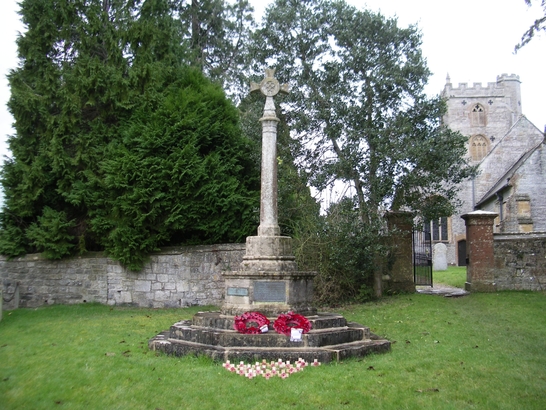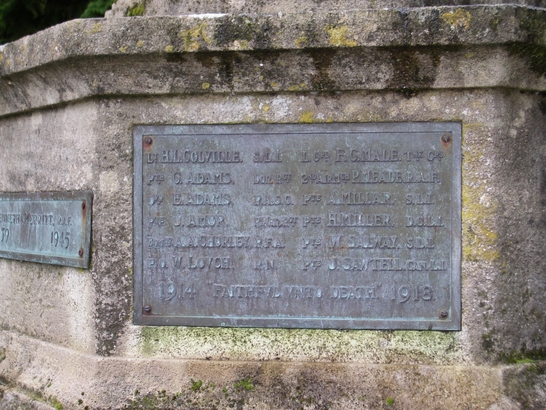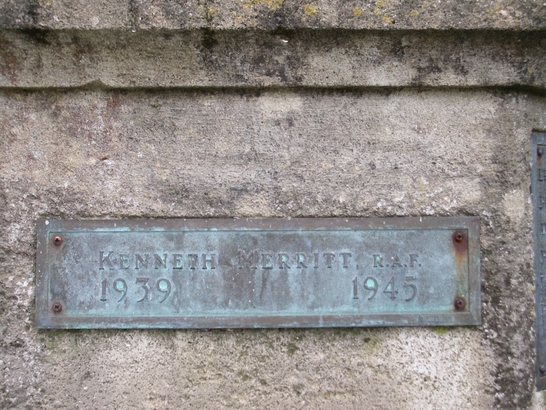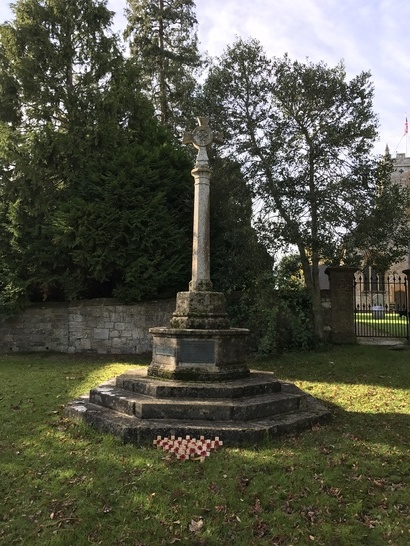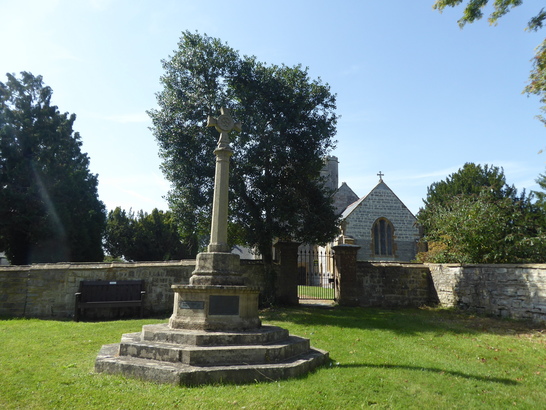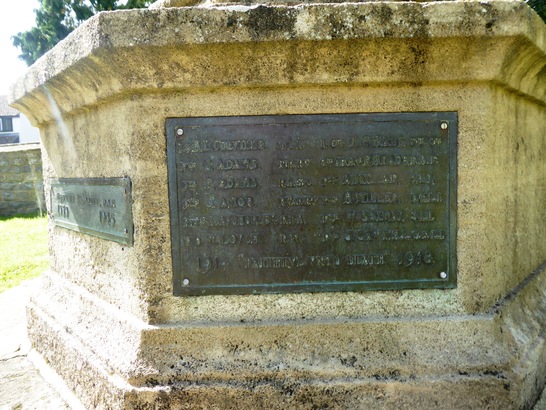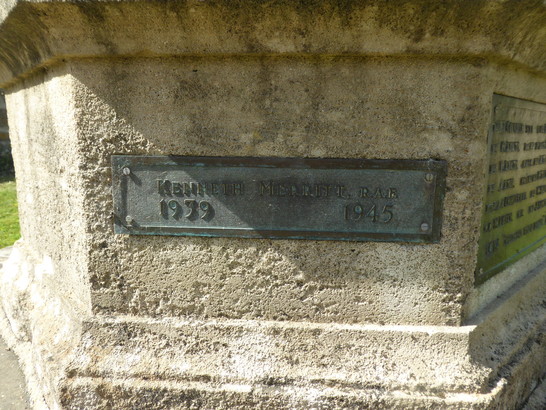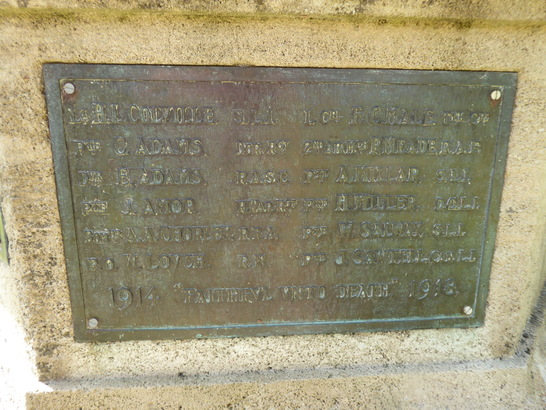-
Full memorial - Taken by War Memorials Trust 28 Jan 2015
-
WWI inscription detail - Taken by War Memorials Trust 28 Jan 2015
-
WWII inscription detail - Taken by War Memorials Trust 28 Jan 2015
-
Fivehead War Memorial - Taken by Philippa Brett 04 Dec 2016
-
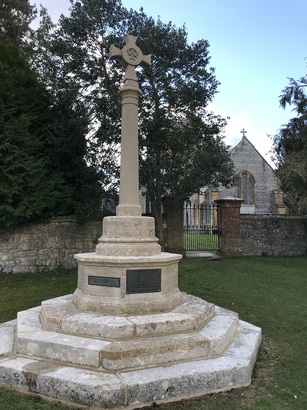
Fivehead Memorial after renovation - Taken by Philippa Brett 28 Mar 2018
-
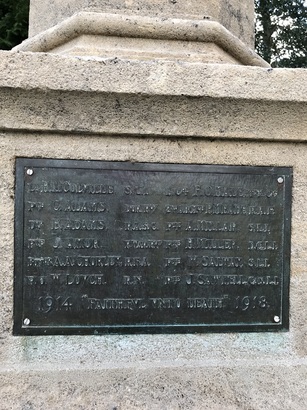
Name plaque WWI - Taken by Philippa Brett 28 Mar 2018
-
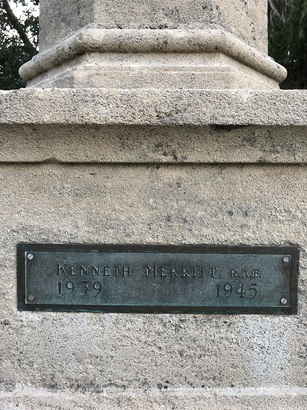
Name plaque WWII - Taken by Philippa Brett 28 Mar 2018
-
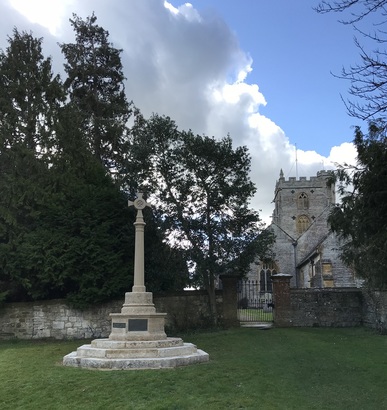
Fivehead Memorial with St Martins Church - Taken by Philippa Brett 28 Mar 2018
-
Fivehead memorial setting - Taken by Jennie Butler 07 Sep 2023
-
View of plaque - Taken by Jennie Butler 07 Sep 2023
-
Smaller plaque - Taken by Jennie Butler 07 Sep 2023
-
Larger plaque - Taken by Jennie Butler 07 Sep 2023
Reference WMO/195822
War Memorials Trust case: War Memorials Trust needs to avoid Contributors changing location/description details as we help to protect and conserve this war memorial through our casework. You can still add photographs, update condition and use the tabs below. If you believe any of the information you cannot edit is wrong or information is missing, please make a note of the reference number and include it in your email when you contact us.
Grants to support the repair and conservation of war memorials are available from the charity War Memorials Trust if it has raised funds. Support is focused on war memorials in Very bad or Poor condition or where there is a serious Concern.
Before applying for a grant you should read the advice available on War Memorials Trust`s website. The What we can and cannot fund helpsheet explains what types of work the charity can fund.
If you believe your project is eligible for a grant you should complete the Pre-application enquiry form. You will need to be registered and logged in to complete this.
The Pre-application enquiry form is a series of questions to see if your project is eligible. If it is, you will need to provide further details and submit current colour photographs of the war memorial in either a png, gif, jpg or jpeg format.
You can save your Pre-application enquiry form as you go along. Once submitted War Memorials Trust will respond.
Please be aware that a summary of your enquiry, without your contact details, will appear on this page once submitted. This ensures others are aware that an enquiry has been made and can read the response to avoid duplicate enquiries. Information provided by you to us will be used for the purpose of managing the grant enquiry, for further details please read our Terms and Conditions and Privacy Policy .
As a charity, War Memorials Trust relies on voluntary donations and every contribution, no matter how large or small, makes a really big difference to our work. Your donation will help protect and conserve war memorials for future generations so please support War Memorials Trust’s work.
1914 - 1918 'Faithful unto death' 1939-1945
Lt. Harold Linklater Colville 1st Bn Somerset Light Infantry----- Before the outbreak of war, Harold had been at Durham University, training to be ordained. He regularly stayed with his Uncle, James Rigbye, Vicar of Fivehead. At the age of 21, Harold went to France in December 1915 initially with the 9th Battalion, Somerset Light Infantry and was later transferred on promotion to the 1st Bn who were deployed on the first day of the Battle of the Somme Lt Colville was shot in the head, fracturing the base of his skull. He was taken to a large clearing hospital near Rouen but died of his wounds on 6th July 1916. He was just 22 years old. He is buried in the Commonwealth War Graves Cemetery at St Sever. ~~~~~~~~~~~~~~~~~~~~~~~~~~~~~~~~~~~~~~~~~~~~~~~~~~~~~~~~~~~~~~~~~~~~~~~~~~~~~~~~~~~~~~~~~~~~~~~~~~~~~~~~~~~~~~~~~~~ Lance Corporal Francis Charles Male 10th Bn Tank Corps & Welch Regiment----- Frank Male came from a large family living in Fivehead and Swell, where his descendants are still to be found today. In 1911 Frank moved to Cardiff with 3 of his 9 siblings and he worked as a car conductor, possibly on the trams in Cardiff. He first joined the Welch Regiment and then transferred to the Tank Corps after it was established in 1916. In April 1915, Frank married Isabel Davies in Cardiff and in September 1916 they had a baby girl (Isabel) Joan. It is not known if Frank ever saw his daughter as after the Somme offensive, very few soldiers made it home on leave from Europe. Frank was killed in action on 26th May 1918, he was 33 years old. It’s not known where he died, but he is buried in the Gommecourt British Cemetery No.2, Hebuterne, France. This cemetery was created when other smaller cemeteries were brought together. Frank’s wife Isabel, now living in Cheriton, Reynoldston, Swansea, received a relief war gratuity in October 1918 and Frank’s full gratuity of £14 in 1919. ~~~~~~~~~~~~~~~~~~~~~~~~~~~~~~~~~~~~~~~~~~~~~~~~~~~~~~~~~~~~~~~~~~~~~~~~~~~~~~~~~~~~~~~~~~~~~~~~~~~~~~~~~~~~~~~~~~~~ Private Clement Adams, Dorsetshire Regiment----- Clement Adams was born in Swell in 1893 and lived in Fivehead with his mother Annie and siblings William, Alice, Herbert, Fred and Clarence. By 1911 Annie had married Henry Grinter and they all lived at Moortown Farm, Swell with Henry’s three children. Clement worked as an ‘under carter’ on the farm, which was a job requiring some skill in driving horses and balancing a load, usually on a two wheeled cart. Clement enlisted in at Porth, Glamorgan, it’s not known why he travelled to Wales to enlist, but his stepbrother, Charlie Grinter was living in LLangeinor at that time. Clement gave his address as North Curry. He was posted to 1st Bn, Dorsetshire Regiment and joined them in Belgium on 27th January 1915. The First Battle of Ypres had ended in November and Clement’s Battalion were tasked with holding the line on the Ypres Salient at Wulverghem. On 14th March 1915 Clement was killed in action at the age of 22 and having been in theatre for just 46 days. His body was never found. He is listed on the Menin Gate at Ypres along with 54,000 names of allied soldiers who died on the Ypres Salient but have no known grave. ~~~~~~~~~~~~~~~~~~~~~~~~~~~~~~~~~~~~~~~~~~~~~~~~~~~~~~~~~~~~~~~~~~~~~~~~~~~~~~~~~~~~~~~~~~~~~~~~~~~~~~~~~~~~~~~~~~~ Driver Ernest Adams, 860 Company, Army Service Corps------ At the outbreak of the First World War, Ernest lived in Swell with his wife, Hannah and their 4-year-old son Bertie. He was a carter on a farm, but had seen active service in 1897/98 in the Punjab and the Boer War, South Africa 1899. Ernest joined the Army Service Corps (Horse Transport) and was posted to the 3rd Base Depot Salonika, Greece. It’s not known when he joined, but his Army number (T2/SR/03929) confirms he was in the first wave of recruits. On 19th August 1917 he was admitted to hospital in Greece, suffering with malaria. He returned to his unit just 10 days later. Malaria was endemic in Salonika, in fact the logo of the Salonika Campaign Society is a mosquito. The men also suffered from dysentery and the campaign followed the pattern of earlier wars where there were more losses to sickness and disease than to enemy action, unlike the Western Front. Ernest died on 5th January 1918 at the 63rd General Hospital, Salonika. There are no details of the circumstances of his death, but it is likely to have been due to illness, rather than enemy action. ~~~~~~~~~~~~~~~~~~~~~~~~~~~~~~~~~~~~~~~~~~~~~~~~~~~~~~~~~~~~~~~~~~~~~~~~~~~~~~~~~~~~~~~~~~~~~~~~~~~~~~~~~~~~~~~~~~~~ Private Joseph Henry Amor, 2/6th Royal Warwickshire Regiment------ Joseph grew up with his 7 siblings in Swell; his father was an agricultural labourer/shepherd and Joseph attended Fivehead School with his brothers and sisters. It’s not known when Joseph joined the Army, but he initially served with 4th Battalion Kings Shropshire Light Infantry and was transferred to 2/6th Royal Warwickshire Regiment. Conscription was introduced just as Joseph turned 18 and the fact that he did not join a local Regiment, suggests he may have been conscripted. Joseph’s Battalion were serving at the front on the Haverskerque/Les Amusoires line, near Merville on the France/Belgium border. On the evening of 11th/12th May his unit moved from their rest area at Hamet Billet to the front, and this is possibly when Joseph was killed. We know from his nephew, Derek Amor, that Joseph was a dispatch rider and was killed by a sniper on 11th May 1918. Joseph was just 20 years old. Joseph is buried in the Commonwealth War Graves Cemetery at Etaples. ~~~~~~~~~~~~~~~~~~~~~~~~~~~~~~~~~~~~~~~~~~~~~~~~~~~~~~~~~~~~~~~~~~~~~~~~~~~~~~~~~~~~~~~~~~~~~~~~~~~~~~~~~~~~~~~~~~~~ Lance Bombardier (Albert) George Chorley, 8th Div Ammunition Col., Royal Field Artillery----- George was just 2 months old when his mother, Ruth died leaving his father, James to look after their eight children, all under the age of 10. George was raised by his Grandmother, Phyllis Marsh of Angel Row, Fivehead and his siblings remained with their father who remarried and moved to Curry Rivel a few years later. George became a baker and was a prominent member of the Baptist Chapel in the Village. He remained in Fivehead until he enlisted at Bristol and joined the Royal Field Artillery, he would have been 35 at the start of the War in 1914. It’s likely that George would have seen service throughout the War; we know he was serving in September 1917 as it was reported in the Langport and Somerton Herald that he had been home on leave for ten days and his friends were pleased to see him ‘looking so well’. At the end of April 1918, five divisions of Commonwealth forces (IX Corps) were posted to the French 6th Army near the River Aisne to rest and refit following the German offensives on the Somme and Lys. Here, at the end of May, they found themselves facing the overwhelming German attack which, despite fierce opposition, pushed the Allies back across the Aisne to the Marne. They suffered 15,000 fatal casualties. On 26th May 1918, George’s unit were ordered to position their heavy guns around the River Aisne area near Reims in Northern France. It’s not known how George was killed, but he is commemorated on the Commonwealth War Graves Memorial at Soissons on the banks of the Aisne. ~~~~~~~~~~~~~~~~~~~~~~~~~~~~~~~~~~~~~~~~~~~~~~~~~~~~~~~~~~~~~~~~~~~~~~~~~~~~~~~~~~~~~~~~~~~~~~~~~~~~~~~~~~~~~~~~~~~ Petty Officer (Clement) William Louch, Royal Navy----- William was born and raised in Fivehead along with his 9 siblings, 4 of whom died under the age of 5. William joined the Navy as a baker/domestic in 1900, aged 16; he served on 15 different ships including the state of the art battlecruiser HMS Indefatigable during the War and reached the rank of Petty Officer Stoker. In 1914/15 he saw action in the Dardanelles, but Indefatigable was the first ship to be sunk on 31st May 1916 at the Battle of Jutland. Just 2 men survived out of 1019, William’s body was never found. He is listed on the Plymouth Naval Memorial. William’s brother Lewis joined up in 1914 at the age of 17 and fought the entire war with the 5th Battalion, Somerset Light Infantry, while his older brother, Charles served in the Navy as a cook and in 1912 emigrated to Canada where in February 1916 he joined the 143rd Battalion, Canadian Expeditionary Force and went to France in March 1917. Charles and Lewis both survived the War. ~~~~~~~~~~~~~~~~~~~~~~~~~~~~~~~~~~~~~~~~~~~~~~~~~~~~~~~~~~~~~~~~~~~~~~~~~~~~~~~~~~~~~~~~~~~~~~~~~~~~~~~~~~~~~~~~~~~~ 2nd Air Mch Reginald Meade, Royal Flying Corps----- Reginald lived in Hill House, Fivehead with his parents and three siblings until he was 15 when he moved to live with his Aunt’s family in Uplowman, Devon and worked on their farm. The rest of the family later moved to their own farm in Bishop’s Lydeard. It’s not known when Reginald joined up, but he became a mechanic in the newly formed Royal Flying Corps, which would become the RAF. He was posted to Egypt where the RFC were supporting the infantry in their advance through Palestine; however, Reginald was killed when his troop ship was near Alexandria. HT "Aragon" was torpedoed and sunk on 30 December 1917, entering the port of Alexandria, with the loss of 380 officers and men of the Commonwealth forces. HMS Attack sailed to their rescue, but she too was sunk by the same U boat. Reginald was 21 when he died and was unmarried, his elder brother Maurice served with the Somerset Light Infantry mainly in the Balkans. Reginald’s initial on our War Memorial is ‘P’ rather than ‘R’. His father’s name was Philip, so he may have used this name. He is also commemorated on the Chatby Memorial in Egypt. ~~~~~~~~~~~~~~~~~~~~~~~~~~~~~~~~~~~~~~~~~~~~~~~~~~~~~~~~~~~~~~~~~~~~~~~~~~~~~~~~~~~~~~~~~~~~~~~~~~~~~~~~~~~~~~~~~~~~ Corporal Alfred Miller, 8th Battalion, Somerset Light Infantry----- Alfred was born in Angel Row, Fivehead in 1891; his father, James was an agricultural labourer and married to Elizabeth, who between them had 11 children. There were 5 girls and 6 boys, 1 of whom died in infancy. 2 of Alfred’s brothers, Ambrose and Silas also joined the Somerset Light Infantry; Ambrose was discharged after just 28 days having lied about his age being just 17 and Silas would also serve in the West Somerset Yeomanry. At the turn of the century, the Millers moved to Western Farm, Swell and by 1911 they were living in Goathurst near Bridgwater. Alfred was employed as a waggoner on a farm. It’s not known when Alfred joined the Army, but his younger brother Ambrose joined in October 1914, so it’s likely Alfred joined then. The 8th (Service) Battalion was raised at Taunton in October 1914 as part of Kitchener’s Third Army, they were attached to 63rd Brigade, 21st Division, which initially concentrated in the Tring area, with troops spending some time in camp, under canvas at Halton Park before winter necessitated a move to local billets. In May 1915 the infantry moved to huts at Halton Park and on the 9th of August they moved to Witley Camp. They proceeded to France on the 10th September 1915 and landed at Le Havre. The Division embarked on lengthy marches and went into action in the British assault at Loos on 26 September, where the Division suffered over 3800 casualties. In 1916 they were in action in The Battle of the Somme and on 8th July 1916 the battalion transferred with 63rd Brigade to 37th Division. In November 1916, the Division took part in the Battle of the Ancre, the final phase of the Battle of the Somme. On 12th November, the Battalion were billeted at Lealvillers, West of Beaumont Hamel. On 14th November, they continued the attack at Engelbelmer; as Alfred was a corporal and not an officer, his death was not recorded in the Regimental diary. His body was never recovered, and he is commemorated on the Thiepval Memorial along with 72,000 soldiers who were never found. He died a single man, with his father collecting his personal effects. ~~~~~~~~~~~~~~~~~~~~~~~~~~~~~~~~~~~~~~~~~~~~~~~~~~~~~~~~~~~~~~~~~~~~~~~~~~~~~~~~~~~~~~~~~~~~~~~~~~~~~~~~~~~~~~~~~~ Private Henry Miller, 1st Bn, Duke of Cornwall’s Light Infantry----- Henry William Miller was born in early 1885 and grew up living in Angel Row, Fivehead with his father John, a farm worker, his mother Miriam, a shirt maker and his younger brothers Walter and Herbert also farm workers. Miriam died in 1898 and John then married Eva. They had three further children; Myra, Alice and William. Henry worked as a cattleman at Stowey Farm, Fivehead and married (Gertrude) Mary from Taunton in 1910. By 1911, Henry and Mary had moved to Pennant Street, Ebbw Vale where he ran his own milk vending business. His brother Walter was also living with them, but was unemployed. Henry then bought his own farm, The Hendre Farm, Newtown, Ebbw Vale. When war broke out in August 1914, Henry joined the DCLI and was soon landing at Le Havre as part of the British Expeditionary Force (BEF). The 1st Bn were among the first to engage the Germans at Mons but were unable to halt their advance. The BEF managed a controlled retreat and entered into a race to the sea to stop the Germans gaining access to France. By October 1914, during the Battle of La Bassee, the 1st Bn were at Violaines, near Lille when the Germans broke through, forcing them from the Town. Henry was killed during this battle on 22nd October 1914, but his body was never found. His name is recorded on the Le Touret Memorial (CWGC), Pas de Calais along with 13,500 British soldiers. Henry was posthumously awarded the Victory Medal and British War Medal and left his farm (valued at £1076 13s 9d) to his wife Mary in his will. ~~~~~~~~~~~~~~~~~~~~~~~~~~~~~~~~~~~~~~~~~~~~~~~~~~~~~~~~~~~~~~~~~~~~~~~~~~~~~~~~~~~~~~~~~~~~~~~~~~~~~~~~~~~~~~~~~~~ Private William Salway, 1st Battalion Somerset Light Infantry----- The Salway family lived in Hill View House, Fivehead and were thatchers by trade. Heman and Harriett had 10 children, 5 of whom were boys who are believed to have all fought in The Great War, apart from Charles who died at the age of 12. William was 16 when war broke out, it’s not known when he joined up, but he enlisted in Taunton with the 1st Bn Somerset Light Infantry. He joined his older brother Sidney in the Battalion and they both fought at Poelcappelle, near Passchendaele during the third Battle of Ypres. The Langport Herald reported that William was wounded in the abdomen on 28th September 1917 and died in hospital on 5th October 1917. Sidney was also wounded that week, his parents receiving notice of their injuries at the same time. William was just 19 when he died. It was reported in the Battalion War Diary, ‘a satisfactory feature of the day was the way in which the last draft of 200 behaved. Though for the most part only 19 years of age, and never having been under fire before, they showed the greatest keenness and determination and behaved excellently. He is buried in Dozinghem Cemetery, near Ypres in Belgium. William’s older brothers, Leonard, Samuel and Sidney all survived. ~~~~~~~~~~~~~~~~~~~~~~~~~~~~~~~~~~~~~~~~~~~~~~~~~~~~~~~~~~~~~~~~~~~~~~~~~~~~~~~~~~~~~~~~~~~~~~~~~~~~~~~~~~~~~~~~~~~ Lance Corporal Jack Sawtell, 8th Bn Canadian Light Infantry----- Edward John Sawtell, known as Jack, was born in 1895 to James and Edith who were living with James’ mother in Fivehead. James was a labourer at Cathanger Farm and they had 11 children in total. In 1906, at the age of 20, Jack’s older brother William emigrated to Canada and started a farm in rural Sasketchewan. Over the next 7 years, the remaining Sawtells apart from 2 siblings, joined Wiiliam on the farm in Manitou Lake. Jack’s eldest brother, Charles had joined the 18th Hussars in 1898 and fought in the 2nd Boer War, enduring the Siege of Ladysmith. It’s not known if he survived. In December 1914, Jack travelled 630 miles to join the Canadian Expeditionary Force, being assigned to the 8th Battalion Canadian Light Infantry (Winnipeg Rifles). They first travelled to Salisbury Plain for training, and then in April 1915 saw their first action at Ypres. At 0400 hrs on the morning of Saturday, 24 April 1915, a blue-green-yellowish cloud was seen rolling over No Man’s Land towards the battalion trenches. It was the second enemy gas attack. Half the battalion succumbed to the poisonous fumes. The battalion on the left was obliged to retire and Colonel Lipsett’s 8th Battalion found itself in danger of being surrounded. But it held on. While supporting battalions were preparing new defences in the rear, the men of the Regiment kept up a withering fire on the enemy, drove off an attack on its front and withstood fearful enfilade fire from left and right, and this from an enemy force five times its size. Thus, began a tradition of never losing a trench to the enemy, a tradition never to be broken throughout the war’s duration. The 8th Bn also fought at Festubert in May 1915; Givenchy in June and Mount Sorrel the following June, where Jack was killed on the 14th. His Battalion were under continuous bombardment for 48 hours with no water or rations; the extreme strain was too much for some soldiers who were seen to walk to their deaths in No Man’s Land, in a confused state. The Battalion lost 1 officer and 195 other ranks, including Jack whose body was not recovered. The Battle of Mount Sorrel lasted for almost two weeks and cost the Canadians over 8,000 casualties. Having lost the first two phases of the battle, the Canadians achieved victory in the final operation. Jack is commemorated on the Menin Gate, Ypres. Jack’s younger brother Herbert also served in the Canadian Expeditionary Force, returning to Canada at the end of the War. The Sawtells remained in Saskatchewan, making a success of their farm at Manitou Lake. ~~~~~~~~~~~~~~~~~~~~~~~~~~~~~~~~~~~~~~~~~~~~~~~~~~~~~~~~~~~~~~~~~~~~~~~~~~~~~~~~~~~~~~~~~~~~~~~~~~~~~~~~~~~~~~~~~ ----------------------------------------------------------------------------------1939 - 1945 -------------------------------------------------------------------------------------------------- Sgt Air Gunner Kenneth Merritt. 150 Squadron, Royal Air Force----- Kenneth’s birth was registered in Langport in 1925, his parents Tom Merritt and Dorothy Burge were from Kingsbury Episcopi and Isle Brewers respectively. His father was a farm labourer, but he died when Kenneth was just 4 years old. It’s not know where Kenneth lived before the War, but his parents lived in Dyers Lane, Curry Rivel after the War. By the age of 19, Kenneth was serving in the RAF. He was an Air Gunner, flying in Lancasters from RAF Hemswell, near Gainsborough, Lincolnshire. As an Air Gunner, his life expectancy would have been just 5 sorties. On 31 December 1944, Kenneth left RAF Hemswell on a mission to Osterfeld, Nr Leipzig, Germany. It was an industrial town with oil tanks and therefore a key target. 149 Lancasters and 17 Mosquitos were sent to attack the railway yards at Osterfeld. The only details available are Bomber Command's estimates that the railway sidings were 35 per cent damaged and the 'facilities' 20 per cent damaged. 2 Lancasters were lost. There were 5 other crew members in Kenneth’s Lancaster bomber, serial number NG164. All are listed on the Commonwealth Wargrave Memorial at Reichswald Forest War Cemetery, near the Dutch border at Nijmegan. Reichswald was created after the Second World War when burials were brought in from all over western Germany and is the largest Commonwealth cemetery in the country. ~~~~~~~~~~~~~~~~~~~~~~~~~~~~~~~~~~~~~~~~~~~~~~~~~~~~~~~~~~~~~~~~~~~~~~~~~~~~~~~~~~~~~~~~~~~~~~~~~~~~~~~~~~~~~~~~
Grade II (England)
1428780
Information Required
Information Required
Fivehead Parish Council
Information Required

